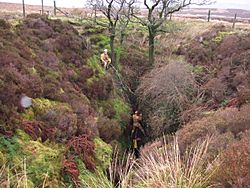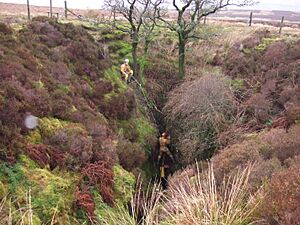Rumbling Hole facts for kids
Quick facts for kids Rumbling Hole |
|
|---|---|
| Fairies Workshop | |

Two cavers rigging the entrance pitch
|
|
| Location | Leck Fell, Lancashire, England |
| OS grid | SD 6717379128 |
| Depth | 126 metres (413 ft) (including cave) |
| Length | 1,091 metres (3,579 ft) (including cave) |
| Elevation | 351 metres (1,152 ft) |
| Discovery | 1899 |
| Geology | Carboniferous limestone |
| Entrances | 2 |
| Hazards | verticality, water |
| Access | Unrestricted |
| Cave survey | cavemaps |
Rumbling Hole is an exciting cave located on Leck Fell in Lancashire, England. It's known for its deep entrance, which is like a big hole in the ground, about 50 meters (164 feet) deep. This cave quickly drops down through several vertical sections called pitches. At the bottom, there's a watery passage that connects to another cave called Lost John's Cave. Rumbling Hole is actually part of a much larger network of caves, the Three Counties System. This huge system is about 87 kilometers (54 miles) long and stretches across three different counties: Cumbria, Lancashire, and North Yorkshire.
Contents
Exploring Rumbling Hole's Passages
The main entrance to Rumbling Hole is a shaft that goes down about 50 meters (164 feet). From there, you follow the water that flows in from Rumbling Beck Cave. This leads into a passage formed by a crack in the rock.
Main Route Through the Cave
After the first big drop, four more pitches take you down into a large chamber. From this chamber, you enter a low, watery passage that's like a canal. If you go upstream, the passage gets too low to continue after about 60 meters (197 feet). But if you go downstream, you can squeeze through some tight bends and watery sections. This path eventually connects to a part of Lost John's Cave. This connecting section of the cave is about 250 meters (820 feet) long.
The Dead Dobbin Series
There's another way to explore Rumbling Hole. A few meters below the west side of the main entrance shaft, you can find another passage. These passages are generally tighter and more complicated than the main route. However, the main path in this series leads down a different set of pitches. It ends at a water-filled section called a sump. This sump is thought to be connected to the upstream end of the canal passage in the main route. This section of the cave, known as the Dead Dobbin Series, is about 350 meters (1,148 feet) long.
Rumbling Beck Cave Connection
Rumbling Beck Cave is where the water comes from that flows into Rumbling Hole's entrance shaft. This water enters about 8 meters (26 feet) below the surface on the east side. The usual entrance to Rumbling Beck Cave is about 50 meters (164 feet) east of Rumbling Hole, where the stream disappears underground. The main passage in Rumbling Beck Cave starts as a crawl. It then opens up into a trench before reaching the main shaft of Rumbling Hole. There's also a passage in the roof, about 20 meters (66 feet) from the end, that leads to another opening in the shaft. Rumbling Beck Cave is about 100 meters (328 feet) long in total.
How Rumbling Hole Was Formed
Rumbling Hole is a solutional cave. This means it was formed by water dissolving the rock. The cave is found in a type of rock called Great Scar limestone. This limestone formed during the Carboniferous period, which was a very long time ago. The cave's shape has been greatly influenced by a large vertical crack in the rock, called a fault. You can see this same fault in nearby caves like Death's Head Hole and Big Meanie.
The water flowing through Rumbling Hole eventually joins Lost John's Cave. From there, it comes out at a spring called Leck Beck Head. Scientists believe that the way water flows through these caves now is fairly new. About 350,000 years ago, Rumbling Hole was a major place where water disappeared underground. This water flowed into passages that are now blocked. It then went through other caves like Death's Head Hole and Gavel Pot. Finally, it would have emerged higher up in the Leck Beck valley, about 100 meters (328 feet) above where the water comes out today. That old exit point is now covered by ancient glacier deposits.
A Look Back: History of Rumbling Hole
Rumbling Hole has been known for a long time! It was first mentioned in a book in 1842 by Jonathan Otley. Later, in 1881, Balderstone described the entrance shaft in detail. He even measured its depth, finding it to be about 46 meters (150 feet). He thought it was a very impressive and beautiful place, describing how the entrance was covered with ivy, holly, and other plants.
First Descents and Discoveries
The very first time someone went down the main entrance shaft was in 1899. This was done by a group called the Yorkshire Ramblers' Club. However, they reported that the passage at the bottom ended in a pool of water. In 1926, another team from the same club managed to go a bit further into the passage that led out of the pool. But bad weather stopped them from going much further.
In 1931, they returned and successfully went down the first of the underground pitches. The first complete trip all the way to the bottom of the main route was made in June 1932. Much later, in 1985, a team from Lancaster University Speleological Society managed to push through the bottom passage. This is how the connection to Lost John's Cave was finally made! The Dead Dobbin Series, which is another set of passages, was explored more recently in 2007 by a group called the Misty Mountain Mud Miners.


